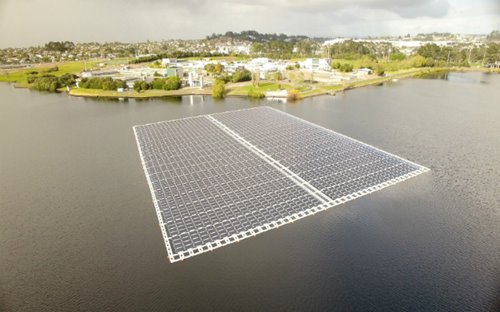New Zealand (NZ) does not have anywhere near the solar resources Australia enjoys, but that isn’t stopping the land of the long white cloud from doing a ‘Jesus-Walk.’ This is to say, NZ has installed its largest solar farm to date, and it also happens to be a floating installation.
Despite its lack of solar and land resources, NZ continues to make Australia look sillier than a Wallabies backline falling all over themselves as an All Black puts the ball down over the line at the other end of the park.
The 1 MW installation floats on a treated wastewater pond at the Rosedale Wastewater Treatment Plant, in Albany, Auckland. It consists of some 2,700 panels atop 4,000 floating pontoons. The array will generate 1,486 MWh of clean energy per year, enough electricity to cover approximately 25% of the treatment plant’s needs, a significant contribution to its long-term goal of being energy neutral.
“Large solar installations like this are common overseas,” said an excited Phil Goff, Auckland’s Mayor, “and it’s good to see we are now making use of the technology in New Zealand.”
Goff noted the installation’s utility for NZ in reaching its climate change goals, goals recently advanced thanks to a forward-thinking National Government. “The one-hectare array will reduce carbon emissions by 145 tonnes each year,” continued Goff, “helping us achieve our climate change goals and making our city cleaner and more sustainable. It will generate enough power to run the equivalent of 200 average New Zealand homes for a year.”
Although the project was announced back in September, 2019, it only took Vector Powersmart four months to construct, including 65 concrete ballast anchors each weighing in at 2.5 tonnes which keep the floating array in place from the depths.
Watercare chief executive Raveen Jaduram said the array is one of five solar projects the utility is looking to develop as a way of reducing costs and emissions simultaneously. “Rosedale is one of the five most energy-efficient wastewater treatment plants in Australasia,” said Jaduram, “most of the wastewater is moved around the plant by gravity and almost all of the energy comes from biogas – a by-product of the wastewater treatment process.”
The energy produced by the solar array will be used to aerate the natural bacteria which break down the waste as part of the treatment process and also for sections of the pumping which cannot be performed by gravity.
Vector Powersmart’s general manager Rogier Simons believes the project’s completion marks a major milestone for solar in New Zealand. “Given the drive to decarbonise and use cleaner forms of energy,” said Simons, “this project is a significant milestone for New Zealand. It also demonstrates that solar solutions can be found even in challenging environments like wastewater treatment ponds.”
Of course, solar is never going to dominate NZ energy market but National utility Transpower believes it could make up close to 10% of the country’s generation mix by 2050. Certainly, if NZ is to boost its solar generation, innovative projects like this floating solar solution will play an important part.
This content is protected by copyright and may not be reused. If you want to cooperate with us and would like to reuse some of our content, please contact: editors@pv-magazine.com.









By submitting this form you agree to pv magazine using your data for the purposes of publishing your comment.
Your personal data will only be disclosed or otherwise transmitted to third parties for the purposes of spam filtering or if this is necessary for technical maintenance of the website. Any other transfer to third parties will not take place unless this is justified on the basis of applicable data protection regulations or if pv magazine is legally obliged to do so.
You may revoke this consent at any time with effect for the future, in which case your personal data will be deleted immediately. Otherwise, your data will be deleted if pv magazine has processed your request or the purpose of data storage is fulfilled.
Further information on data privacy can be found in our Data Protection Policy.